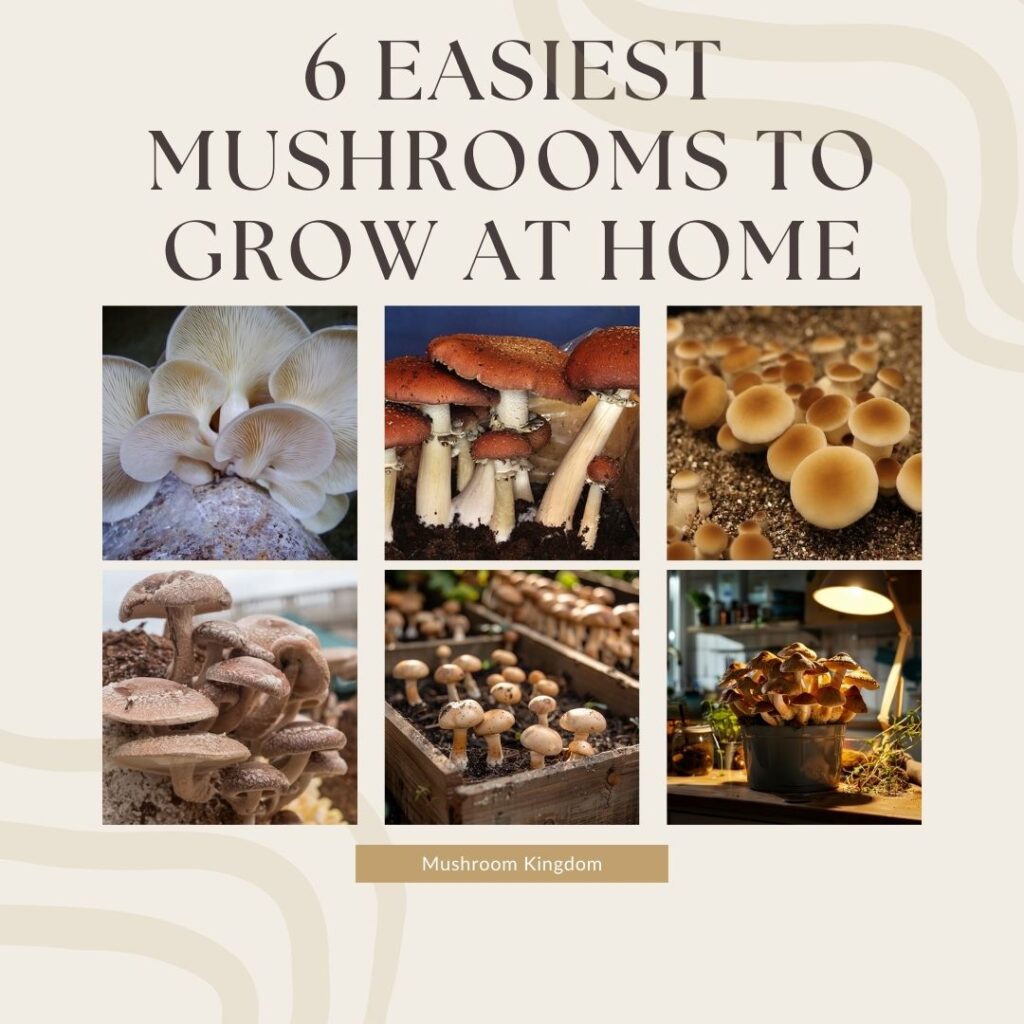Chanterelle mushrooms are one of the most beautiful fungi you can find in nature, also very beneficial to your health and popular among cooking enthusiasts.
In this article, you are going to learn how to identify them, separate them from common look-alikes, cook and store them, and benefit from consuming them.
How To Identify A Chanterelle Mushroom?
Chanterelles are typically bright orange or yellow, though colour can vary. They have a funnel-shaped cap with wavy edges and a smooth surface. The underside of the cap features ridges, rather than gills, which extend down the stem.
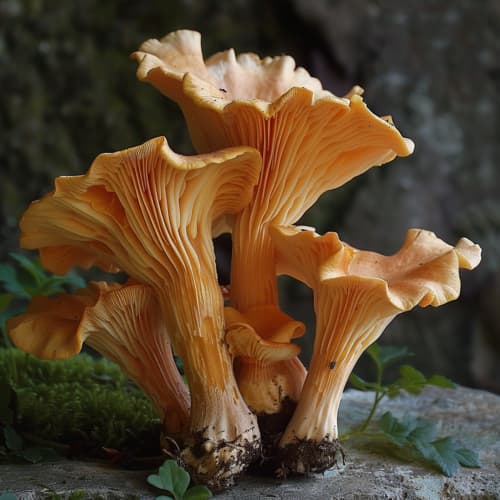
- Size and Shape: Chanterelles vary in size, but they generally have a wide, vase-like shape. The cap can range from 2 to 6 inches in diameter.
- Texture: Chanterelles have a firm and meaty texture, which sets them apart from many other mushrooms.
- Scent: They often have a fruity or apricot-like aroma, which becomes more pronounced when they’re cooked.
- Habitat: Chanterelles are commonly found in forests, particularly near coniferous trees or in mixed woodlands. They often grow in mossy areas, on the forest floor, or near decaying wood.
- Time of Year: They typically appear in late summer to fall, depending on the location and climate.
- Look-Alikes – While chanterelles have distinct features, there are some mushrooms that resemble them, such as the false chanterelle. It’s essential to be cautious and ensure positive identification, especially if you’re foraging for wild mushrooms.
When Is The Best Time To Forage Chanterelles?
The best time to forage for chanterelles is in late summer to fall. In many regions, this means you’ll find them from June to November. However, specific timing can vary based on factors like temperature, rainfall, and local environmental conditions.
In cooler climates, chanterelles may start to appear later in the summer or early fall, while in warmer areas, they might emerge earlier in the summer and continue into the fall months.
Keep an eye out for chanterelles after periods of consistent rainfall followed by warm, humid weather. These conditions are often conducive to their growth. Also, pay attention to the habitat where they typically grow, such as forests with mixed woodlands or near coniferous trees.
Chanterelle Mushroom Look-Alikes
While chanterelles have distinct features, there are some mushrooms that resemble them like:
False Chanterelle (Hygrophoropsis aurantiaca)
This mushroom shares a similar orange color and grows in the same habitats as true chanterelles.
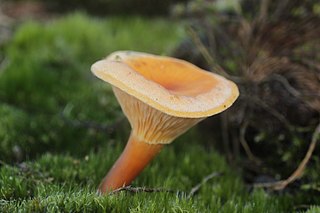
However, it has a smoother cap surface and lacks true gills; instead, it has forked or veined gills. False chanterelles also have a stronger, more unpleasant odor compared to the fruity aroma of true chanterelles.
Jack-o’-Lantern Mushroom (Omphalotus illudens)
Jack-o’-lantern mushrooms are orange and often found in clusters at the base of trees, much like chanterelles.
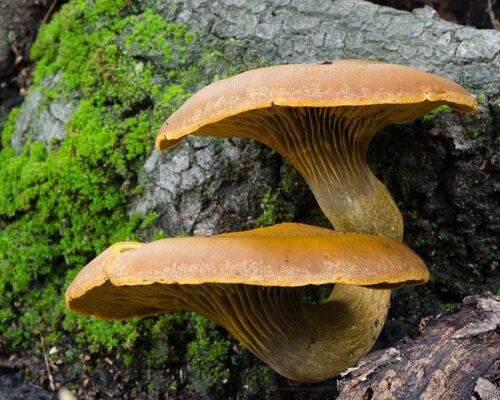
However, they grow directly from wood, whereas chanterelles grow from the ground. Additionally, jack-o’-lantern mushrooms have true gills (though they are often mistaken for ridges) and emit a faint bioluminescent glow in low light conditions.
Yellowfoot Mushroom (Craterellus tubaeformis)
Also known as winter chanterelle, this mushroom is similar in color to chanterelles but has a thinner, more delicate stem. The cap is often more funnel-shaped than the typical chanterelle, and the ridges on the underside are not as pronounced.
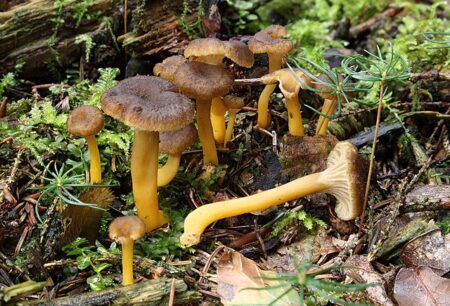
Sulphur Tuft (Hypholoma fasciculare)
While not resembling chanterelles as closely in appearance, sulphur tufts can sometimes be confused with chanterelles by inexperienced foragers due to their bright yellow-orange color. However, sulphur tufts have true gills and grow in dense clusters on decaying wood, unlike chanterelles.
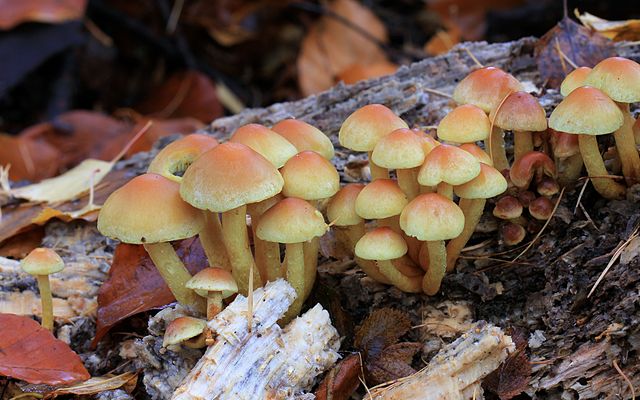
Golden Waxcap (Hygrocybe chlorophana)
These mushrooms are bright yellow-orange like chanterelles, but they have a smoother cap surface and grow in grassy areas rather than in forest environments. Additionally, golden waxcaps have true gills.
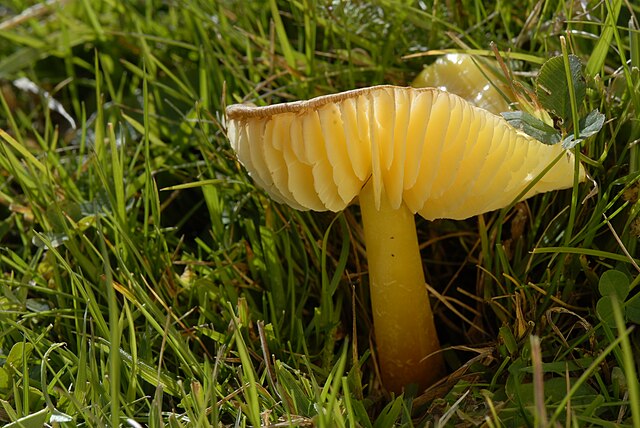
Are Chanterelles Good For Your Health?
Yes, chanterelle mushrooms are not only delicious but also offer several health benefits:
- Nutritional Value: Chanterelles are low in calories but rich in nutrients. They contain important vitamins and minerals such as vitamin C, vitamin D, potassium, and various B vitamins.
- Antioxidants: Like many other mushrooms, chanterelles contain antioxidants that help protect your cells from damage caused by free radicals. These antioxidants may contribute to reducing the risk of chronic diseases such as heart disease and cancer.
- Immune Support: Some research suggests that certain compounds found in mushrooms, including chanterelles, may have immune-boosting properties. Consuming chanterelles as part of a balanced diet may help support your immune system.
- Digestive Health: Chanterelles are a good source of dietary fiber, which is important for digestive health. Fiber helps promote regular bowel movements, prevents constipation, and may reduce the risk of digestive disorders such as diverticulosis and colorectal cancer.
- Low in Fat and Sodium: Chanterelles are naturally low in fat and sodium, making them a healthy choice for those watching their fat and salt intake.
- Potential Anti-inflammatory Effects: Some studies have suggested that certain compounds found in mushrooms, including chanterelles, may have anti-inflammatory effects. Chronic inflammation is linked to various health conditions, so consuming foods with anti-inflammatory properties may be beneficial for overall health.
What Do Chanterelle Mushrooms Taste Like?
One of the most distinctive aspects of chanterelle mushrooms is their fruity aroma and flavour. Some describe it as reminiscent of apricots or peaches. This fruity note is particularly noticeable when the mushrooms are cooked.
While chanterelles have a fruity overtone, they also possess an earthy flavour that is characteristic of many mushrooms. This earthiness adds depth to their taste profile.
Some people detect a subtle peppery or spicy undertone in chanterelle mushrooms, notably in the stem and base.
Despite their robust texture, they have a delicate flavour that is not overpowering. This makes them versatile in various culinary applications, as they can complement other ingredients without overshadowing them.
Like many mushrooms, chanterelles contain natural umami compounds, which contribute to their savoury taste. This umami richness adds complexity to dishes and makes chanterelles a prized ingredient in many cuisines.
Best Ways To Cook Chanterelles
Chanterelle mushrooms are versatile and can be cooked in various ways to showcase their unique flavor and texture. Here are some popular methods for cooking chanterelles:
Sautéing
Sautéing is one of the best ways to bring out the flavour and texture of chanterelles. Heat some butter or olive oil in a skillet over medium heat, then add cleaned and sliced chanterelles. Cook them until they are tender and lightly browned, stirring occasionally. Season with salt, pepper, and herbs like thyme or parsley.

Full Recipe here: Chanterelle Mushroom Creamy Sauce
Roasting
Roasting chanterelles intensifies their taste and gives them a slightly crispy texture. Preheat your oven to 400°F (200°C). Toss cleaned and halved chanterelles with olive oil, salt, pepper, and any desired herbs or spices. Spread them out on a baking sheet in a single layer and roast for about 15–20 minutes, or until they are golden brown and tender.
Grilling
Grilling chanterelles adds a smoky flavour and caramelizes their natural sugars. Preheat your grill to medium-high heat. Toss cleaned chanterelles with olive oil, salt, pepper, and any desired seasonings. Place them directly on the grill grates and cook for 5–7 minutes, turning occasionally, until they are tender and lightly charred.
In Pasta Dishes
Chanterelles pair wonderfully with pasta. Cook your favourite pasta according to package instructions, then toss it with sautéed chanterelles, garlic, shallots, and fresh herbs like parsley or basil. Finish with a drizzle of olive oil and grated Parmesan cheese for a simple and delicious meal.
Can You Eat Chanterelles Raw?
While technically edible, it’s generally not recommended to eat chanterelles raw. Like many wild mushrooms, chanterelles contain compounds that can be difficult to digest and may cause gastrointestinal discomfort for some people when consumed raw.
Cooking chanterelles helps break down these compounds, making them more palatable and easier to digest.
Also, cooking chanterelles enhances their flavour and texture, bringing out their natural sweetness and aroma. Sautéing, roasting, grilling, or otherwise cooking chanterelles can intensify their flavour profile and transform them into delicious additions to various dishes.
How To Store Chanterelle Mushrooms?
If you’re not planning to use your chanterelles right away, store them in the refrigerator. Place them in a paper bag or a loosely wrapped paper towel to allow for air circulation. Avoid storing them in airtight plastic bags or containers, as this can cause them to become slimy and deteriorate more quickly.
Avoid Moisture – Chanterelles are prone to moisture retention, which can lead to spoilage. To prevent this, do not wash them until you’re ready to use them. Excess moisture can cause them to become slimy. If they’re dirty, gently brush off any dirt or debris with a soft brush or cloth.
Use the Crisper Drawer – Store chanterelles in the crisper drawer of your refrigerator, where humidity levels are higher and temperature fluctuations are minimal. This helps maintain their freshness for a longer period.
Check Regularly – Chanterelles are best used within a few days of purchase, as they can deteriorate relatively quickly. Check them regularly for any signs of spoilage, such as mould, sliminess, or a foul odour, and discard any that appear to be past their prime.
Freezing – While fresh chanterelles are preferred for their texture and flavour, you can also freeze them for longer-term storage. Clean and slice the mushrooms, then spread them out on a baking sheet in a single layer and freeze until firm. Once frozen, transfer them to a freezer bag or airtight container and store them in the freezer for up to several months.

